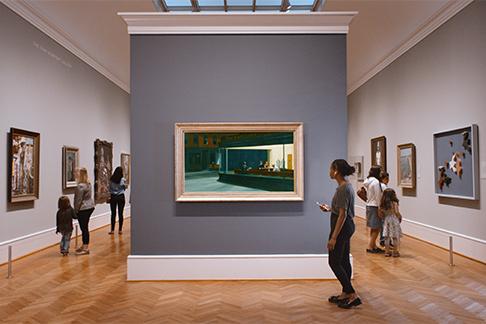Libre
Soutien

From a playfully provocative cheerleader routine to the erotic underwater girl-on-girl contortionist act be amazed by Zumanity by Cirque du Soleil The Sensual Side of Cirque du Soleil
Madame Tussauds There’s so much to see and do at Madame Tussauds New York! Get up close and personal with over 200 life-like wax figures of the biggest stars and icons in entertainment, sports, history and more. Mingle with movie stars in your own A-list party before getting on stage with your favorite pop star. Address the world alongside famous leaders and then challenge legendary athletes on the court. Don’t miss the Marvel Super Heroes 4D Experience, a short film with thrilling special effects that make you ‘feel” like part of the action. Located in the heart of Times Square, no visit to NYC is complete until you’ve experienced the world famous Madame Tussauds. From Marilyn to Madonna to Gaga, there is a star for every generation. VIP Dine 4 Less Card - New York One card is valid for up to 4 persons making this perfect for the entire family or a group of friends, plus there are no limitations on how many times you can use the card within a 30 day period. All you need to do is show your New York VIP Dine 4 Less Card at participating restaurants to receive your exclusive discount on your meal. Please visit http://www.dine4lesscard.com/restaurant_compact_view_new_york for participating restaurants.
Monuments @ Nite guided bike tour is the ultimate Washington DC highlights tour.
Spend a few hours exploring the monuments and memorials as the sun sets over the National Mall; your guide will share unique facts and history at each stop before allowing a few minutes for exploration and photos. No other tour in DC will get you an up close look to as many sites in the same amount of time. Those on foot will envy you!
On this tour, you will see: The Washington Monument, Jefferson Memorial, Franklin Delano Roosevelt Memorial, Martin Luther King Memorial, WWII Memorial, Korean War Veterans Memorial, Vietnam Veterans Memorial, Lincoln Memorial, Albert Einstein Memorial and the White House.
Inclusions: Guided tour includes comfort bike rental, helmet, snack, bottled water, safety lights, and reflective vest
NOT included: Gratuities
Discover the city as you pedal along on one of our comfortable bikes with our friendly guide who will tell you about the historic details, the fascinating experiences of everyday life in the city and its iconic landmarks and sights on this easy-going route. Go on a relaxing cycle tour of Barcelona and visit unique cultural sights such as the Museu d’Art Contemporani, in the Raval neighbourhood, which has its own Rambla with its own unique inhabitant, Botero’s ‘Cat’. The guide will tell you some curious anecdotes about the neighbourhood and will then take you to the plaça Reial, the plaça Sant Jaume, the charming plaça de San Felipe Neri, the majestic Cathedral, the Roman walls and the plaça del Rei, among many other landmark sights. Next, you’ll head down to the seafront and beaches where you’ll be able to stop, time permitting. You’ll visit the old harbour, the Port Vell, the Barceloneta district, the Olympic Marina and, on the way back, you’ll cycle through the Parc de la Ciutadella and stop at the Sagrada Família. And during the hot summer nights you’ll also be able to go on one of our night-time tours! Exploring the city by bike is a wonderful way to experience Barcelona day or night.
Die Classic Tour Entdecke wie der Irische Whiskey den weltweiten Whiskeymarkt beeinflusste. Das Konzept der Führung ist einzigartig, es hebt sich von den üblichen Whiskeyführungen in Irland ab. Das besondere an dieser Führung ist, dass Sie alle Whiskeymarken berücksichtigt und die fesselnde Geschichte des Irischen Whiskeys als Ganzes betrachtet und nicht auf einzelne Destillationsprozesse schaut. Während der rund einstündigen Führung werden Sie von sachkundigen Guides durch die 5 Ausstellungsräume und die verschiedenen Äras des Whiskeys geführt. Neben der mitreißenden Geschichte halten die Guides natürlich auch spannende Anekdoten bereit. Selbstredend gehört auch eine professionelle Verkostung samt Anleitung dazu; so wird Ihnen beim nächsten Whiskeyabend niemand mehr etwas vormachen können. Während deer klassischen Whiskey-Tour dürfen Sie 3 Whiskeys probieren.
Did you know that Christopher Columbus chose to disembark in Barcelona harbour when he returned from his voyage to America?. To commemorate the event, we suggest you visit the Monument dedicated to this illustrious figure. You'll be able to admire the sculptural ensemble around the base of the magnificent Corinthian-style iron column which has a lift inside that takes you all the way up to the viewing gallery at the top. When you get to the top, you'll be able to enjoy stunning 360º views. For instance, to the north, you'll see the Gothic Quarter with the bell towers of the cathedral, Santa Maria del Mar and La Mercè or the bustling Rambla. To the south, you'll see Mount Montjuïc, with the castle at the top. Montjuïc is also the site of museums, gardens, theatres and the Olympic Ring. If you look down, you'll see the Royal Shipyards, the Drassanes, which are home to the Museu Marítim. If you look east and follow the coastline, you'll be able to make out the modern Forum area with its characteristic photovoltaic roof and skyscrapers. Closer to you, the twin towers mark the entrance to the Olympic Marina. At your feet you'll see the old harbour, the Port Vell, and the industrial port. Finally, to the west, you'll see the Parc Natural de Collserola, the vast green "lung" that surrounds the city, with the Collserola Tower and Tibidabo Amusement Park at the top.
